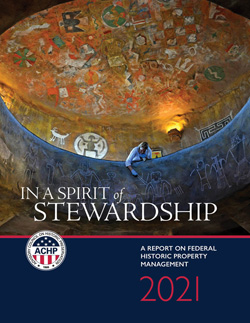In a Spirit of Stewardship: A Report on Federal Historic Property Management (2021)
Synopsis

Executive Summary
This is the sixth report to the President, required every three years under Executive Order (EO) 13287, “Preserve America,” addressing the state of the federal government’s efforts to identify, protect, and utilize their historic properties and their contribution to local economic development. EO 13287 reinforces the role of federal agencies as stewards of their historic properties and underscores the importance of federal agency efforts to inventory, protect, and use these properties. Federal historic properties play a diverse range of roles, from providing infrastructure critical for agency missions, to housing members of the military and federal offices, as sacred places important to Native Americans and Native Hawaiians, to sharing stories of American history with visitors.
Information in this report is derived primarily from the 22 federal agency progress reports submitted to the Advisory Council on Historic Preservation (ACHP) and the Secretary of the Interior. Agency reports focused on progress made in identifying, protecting, and using historic properties in federal ownership since the last report in 2018. Federal agencies continue to provide creative examples of historic properties adaptively reused and rehabilitated to be energy efficient and resilient, as well as historic properties leased or disposed to parties responsible for their preservation. Collectively, these reports also demonstrated that there remains wide-spread support among the public for the protection and use of historic properties, and that federal efforts to do so strengthen communities and contribute to a stronger economy through the creation of jobs.
This 2021 report continues the level of reporting established in the 2018 report by being designed from the start to be web-based, with links to other documents and preservation resources mentioned in the text and containing examples and case studies of successful federal agency stewardship to better illustrate the breadth of historic properties owned by the federal government, the myriad ways agencies care for them, and how they can contribute to the goals of economic development and resource independence.
In addition to the review of the agency progress reports, the challenges and recommendations presented in Chapter 5 of this report also are informed by the ACHP’s extensive, and nationwide, interaction with federal agencies and preservation partners on various undertakings, programs, and initiatives over the last three years. The preservation findings and conclusions identified over the current reporting cycle include the following:
- Leasing historic federal buildings to nonfederal partners promotes their productive use and contribution to local economies, often increasing public access and even transferring maintenance and capital improvement costs to partners in certain circumstances. However, outleasing programs remain small due to inconsistencies among federal agencies in their scope and application, conflicting policies and priorities, limited awareness of these programs, and local economic conditions affecting the availability of partners.
- Agencies are advancing in the use of digital tools to better inform real property management, but further improvement is needed to fully integrate historic property information and realize all potential benefits from increased review efficiency for federal and nonfederal project planning.
- While the primary benefit of partnerships is to leverage limited federal resources and assist federal agencies in the identification, protection, and use of historic properties, partnerships also contribute important community and educational benefits, including those that enable job training.
- Agencies have effectively used Section 106 program alternatives to tailor Section 106 project reviews for multiple land- and property-managing agency benefits, including focusing limited resources on preservation priorities and contributing to comprehensive historic property management strategies. Program alternatives have also improved efficiency and effectiveness of project reviews for infrastructure projects affecting historic properties on federal lands.
- Agencies should ensure timely involvement of and active collaboration with Indian tribes and Native Hawaiian organizations in property management activities and infrastructure planning.
- As more properties associated with the role of the federal government in advancing science and technology in the late 20th century become eligible for the National Register of Historic Places, they present unique management challenges for federal agencies in preserving their significant characteristics while enabling ongoing use.
Recommendations to address these findings are presented in Chapter 5.
The ACHP is committed to assisting federal agencies in implementing these recommendations so that future actions proposed by the Administration, departments, and agencies recognize historic properties as important public assets that should be included in federal real property management strategies and initiatives that address infrastructure renewal, energy efficiency, resiliency, and long-term preservation.
Click here for the 2021 report.